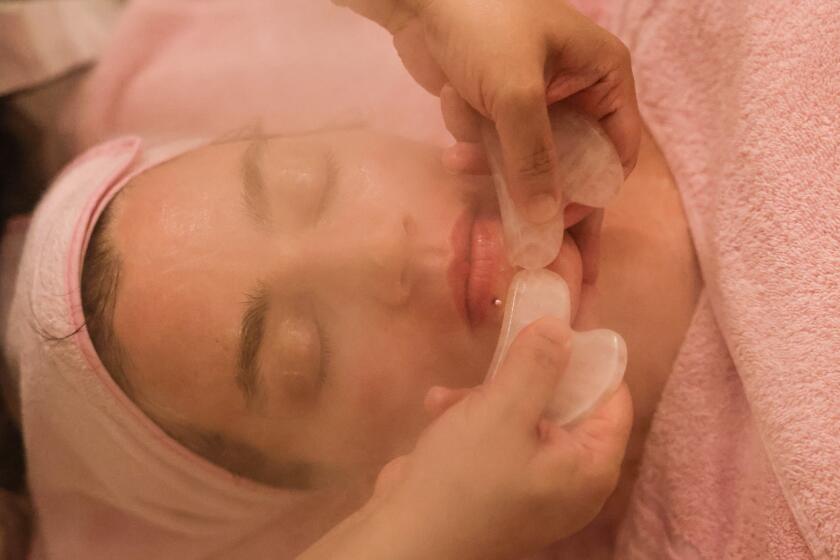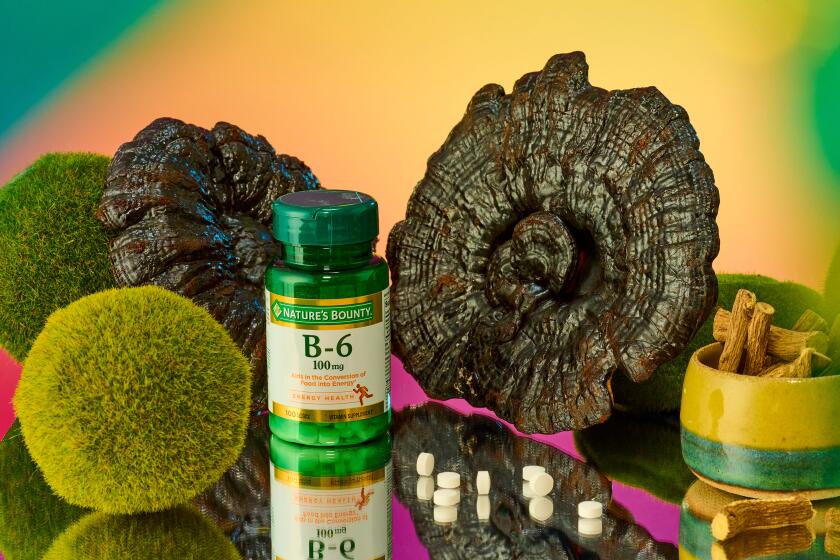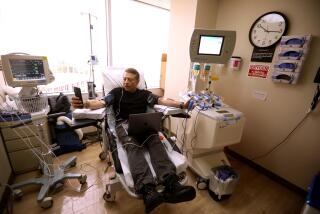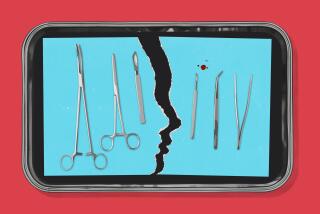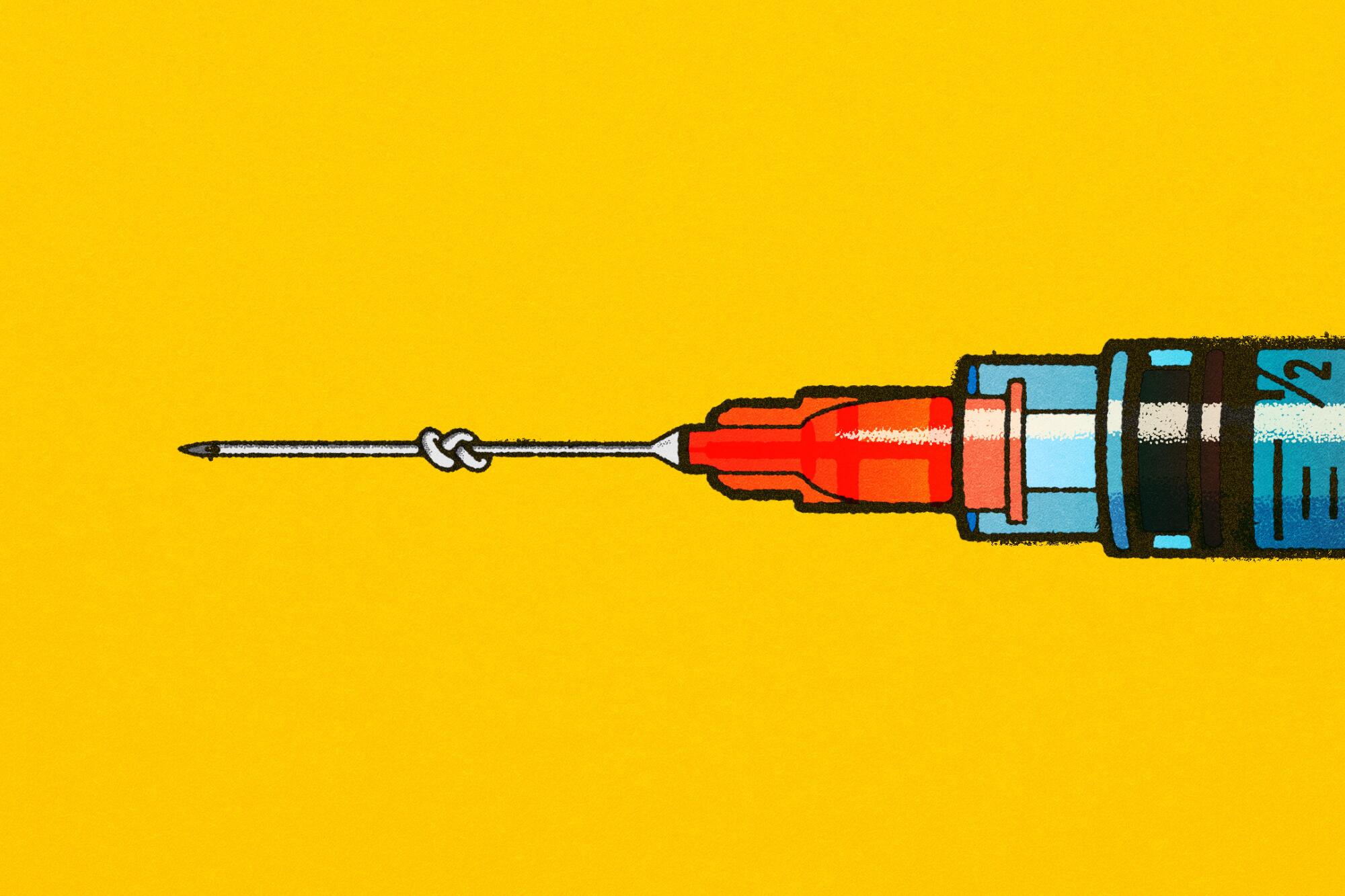
When Ali Weiss, 30, shares a selfie on Instagram, she often adds a disclaimer: This is a face that hasn’t had any work done.
“The most punk thing you can do in 2024 is not f— with your face,” the New York City-based on-air host and podcaster writes via email. Surrounded by peers who got fillers early and often, she believes her choice puts her in “the minority,” especially for those working in front of the camera. “The fact that people seem to be more shocked by a-30-year old who hasn’t gotten work done than a 30-year-old whose entire face is frozen is bonkers,” she says.
Weiss writes of her filler-less face with pride, but she still cares about her youthful appearance. She has several less-invasive treatments in her arsenal, including a red-light therapy gadget, laser facials and facial massages. In a few years, she hopes to try more invasive laser treatments that cost thousands. Anything before considering injectables.
The “face tendon” or “TikTok” facial at San Gabriel’s JY Beauty uses gua sha and lymphatic massage to firm and lift skin and reduce signs of aging.
For the last few decades, the consumer base for neuro-modulators like Botox and dermal fillers like Juvuderm has grown exponentially. In 2010, more than 5.3 million people got Botox and more than 1.7 million received filler in the U.S. In 2022, 8.7 million received Botox and more than 6.2 million received filler, according to the American Society of Plastic Surgeons. Especially in recent years, these procedures have gone from an indulgence for the wealthy and famous to casual and frequent appointments that cost a few hundred dollars.
“They are incredibly effective, relatively low cost and have become part of an accepted mainstream lexicon for self care,” said Dr. Steven Williams, president of the plastic surgeons’ group.
But now, a number of beauty-conscious consumers are saying “no” to injectables and directing their money toward expensive natural treatments instead.
Marta Freedman, 33, is one of them.
“I grew up in the era of excess injections and the Kardashian era, so for me, it makes sense that the pendulum would swing the other way as people investigate alternatives,” the L.A.-based entrepreneur said.
Weiss and Freedman are among a chorus of anti-injectable sentiment on social media and in beauty publications that has intensified in recent years.
“The art is in making the work disappear and look like nothing has happened.”
— Dr. Ava Shamban, founder of Skinfive Medical Spa in Pacific Palisades
TikTok and Instagram feature thousands of videos of (mostly) women chronicling the process of dissolving their filler. The sometimes painful process can take multiple sessions and is done by injecting an enzyme called hyalase that can cause facial features like lips to bruise and balloon before settling back into their original shape.
Many Los Angeles-based practitioners are noting filler fatigue among their clientele. They’ve seen more patients who are asking not only for their fillers to be dissolved but also seeking alternative procedures to maintain an enhanced, albeit more technically natural, look.
“There is a pendulum swing back to the more natural, best version of yourself, similar to the ‘no makeup makeup look,’” said Dr. Ava Shamban, founder of Skinfive Medical Spa in Pacific Palisades. “The art is in making the work disappear and look like nothing has happened.”
External and internal ageism permeates our society. Here’s how to step away from the young is good, old is bad dichotomy and embrace getting older.
So what are the beauty-obsessed, but Botox-averse doing instead? Some will pay top dollar for all-natural ancient practices, while others opt for high-tech, sometimes painful treatments — just so long as they can say they’re toxin-free.
Julie Civiello Polier has amassed more than 120,000 followers on Instagram by espousing noninvasive anti-aging facial massage techniques. Before the pandemic, the Los Angeles-based aesthetician and Chinese medicine practitioner offered in-person facials to her celebrity clientele, including Goldie Hawn, Miranda Kerr and Christy Turlington, but has since moved her practice online, teaching clients massage techniques for facial lifting and sculpting.
Her Instagram videos — with titles like “Support for ovaries and eyebrow lift” and “No Botox needed forehead sculpting” — have built her a dedicated audience . The services she provides range from live-streamed classes on DIY face-lifts (that cost $100 per ticket) to one-on-one coaching packages, priced at more than $2,000.
“I don’t feel aligned with filler or Botox, I prefer myself with a more natural look.”
— Marta Freedman, L.A.-based entrepreneur
Angela Cravens, a 45-year-old copywriter based in San Diego who prefers chemical-free beauty products and Eastern-inspired natural practices, is one of her followers. Since finding Polier’s free tutorials on Instagram, she’s built a gua sha and facial routine that works for her. She says people often mistake her for being younger than she is — something she posits may be because she avoids injectables, “not the other way around.”
Polier says her clients come for the aesthetic benefits but find unexpected emotional release from her techniques. Inspired by traditional Chinese medicine, she believes inner traumas can affect parts of the face.
“This one client kept getting surgeries on one part of the face and it kept kind of drooping back down or kept kind of being really inconsistent with the other side, until we started looking at her relationship with her father,” Polier said. “That left side of the face is where our relationship to [our] father is stored.”
In “Ageless Aging, social researcher Maddy Dychtwald offers a holistic guide to improving your longevity.
In West Hollywood, a three-year-old cosmetic acupuncture practice called the Reset caters to people in their late 20s to 40s who don’t want to try injectables. Owner Toni Weinrit, a board certified and licensed doctor of acupuncture and Chinese medicine, says that although some of her older clients still use injectables, the younger generation is thinking twice.
Freedman, the L.A.-based entrepreneur, found Weinrit on Instagram and did weekly treatments at the Reset for about 10 weeks last year. She plans to resume them there soon. (In the meantime, she’s supplementing with at-home electrocurrent devices, Frownies wrinkle reducing patches and professional facial massages).
“I don’t feel aligned with filler or Botox. I prefer myself with a more natural look,” she said.
Weinrit charges $250 a visit for the service, advising a regimen of 10 sessions across five to 10 weeks (after which she recommends once-a-month maintenance, combined with occasional $500 microneedling, which she said aids in improving skin texture).
A new category of beverages advertises so-called adaptogens, ingredients that companies claim can help you manage stress, enhance creativity and sharpen focus. Is that true?
The American Institute of Alternative Medicine says cosmetic acupuncture “operates on the belief that the face reflects the body’s internal balance and health.” While the practice is rooted in more than 2,000 years of traditional Chinese medicine, there have been limited scientific studies investigating its benefits on facial skin elasticity.
Though Weinrit’s services are significantly more expensive and time-consuming than your average Botox or filler treatment, her schedule is booked. She theorizes that that’s because the results are gradual.
“If you get Botox, 24 to 48 hours later, you have a different face,” said Weinrit. “This is not that.”
Some clinics have begun counseling patients about the changes they want to make, going so far as to refuse requests that won’t look natural.
“If you get Botox, 24 to 48 hours later, you have a different face. This is not that.”
— Toni Weinrit, owner of West Hollywood acupuncture studio The Reset
Cosmetic nurse Vanessa Lee nearly left the industry after being asked to give lip injections to a teenage girl with her mother’s approval. In 2018, she opened The Things We Do, a medspa in downtown’s Arts District (now with locations in Chino Hills and Venice too) that focuses on a moderate approach. Lee, who has more than a decade of experience, says the medspa receives so many requests to dissolve filler done by other practitioners that she has had to begin charging for the once-complimentary service.
The Things We Do has a naturopathic doctor, a licensed healthcare provider on staff who is trained to address skincare through gut health. Lee says she has turned away patients who request excessive work and has referred them to a therapist.
“If somebody comes in and they’re saying things like ‘This guy just broke up with me’ or ‘I’ve been through the hardest year,’ maybe they’re not at a place to be making a big decision about full facial balancing while they’re in this emotional state that needs a bit of support,” she said. “Let’s start somewhere else first.”
Even so, Lee is running a business. For patients who are seeking a youthful refresh, she and her nurses first suggest bio-stimulating treatments like platelet-rich fibrin matrix.
How a concept created and coined by Carl Jung became the latest pop psych buzzword for self-discovery on social media.
The treatment, which clinical studies have shown can reduce wrinkles and hyperpigmentation, involves drawing a patient’s blood, extracting the plasma from it and either injecting it in the face for those with volume loss in a specific place or using it with microneedling devices for patients with thin or dull skin.
One session starts at $1,100 for results that can last up to two years when done twice. Yes, needles are used, but no foreign bodies are injected into the face, a technicality that is meaningful to clients who want to avoid chemicals.
The procedure is proof that, though the pendulum may be swinging toward a more natural approach and look, one thing will never go out of style: the willingness to pay — and suffer — for the promise of beauty.
More to Read
Sign up for The Wild
We’ll help you find the best places to hike, bike and run, as well as the perfect silent spots for meditation and yoga.
You may occasionally receive promotional content from the Los Angeles Times.
